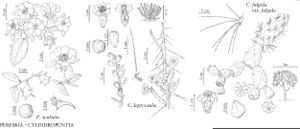Pereskia
Gard. Dict. Abr. ed. 4, vol. 3. 1754.
| Taxon | Illustrator ⠉ | |
|---|---|---|
 | Pereskia aculeata Cylindropuntia leptocaulis Cylindropuntia fulgida var. fulgida | John Myers John Myers John Myers |
Stems straight or zigzag. Spines 1–12 per areole. Flowers from areoles of new growth, fragrant or not; outer tepals often greenish, colored near margins; inner tepals white, yellow, orange-red, red, pink to purplish; stamens 50–100 in small-flowered species, to 300 in large-flowered species; filaments colorless near base, in some species pigmented distally, color either matching inner tepals or contrasting with them; styles shorter to longer than stamens; stigma lobes 3–20. x = 11.
Distribution
Introduced; tropical and subtropical regions in the New World, primarily South America
Discussion
Species 17 (2 in the flora).
Whether the populations of Pereskia in the flora area are reproducing sexually or maintaining themselves solely by vegetative means remains unclear. The population biology of both species and their long-term persistence in the flora need to be monitored.
Selected References
Lower Taxa
Key
| 1 | Plants clambering shrubs or vines; first spines formed in each areole recurved and clawlike, secondary spines straight; fruits not angled, less than 40 × 15-25 mm, never proliferating; flowers fragrant | Pereskia aculeata |
| 1 | Plants erect shrubs or trees; all spines straight; fruits angled, 50-100 × 30-70 mm, often proliferating; flowers not fragrant | Pereskia grandifolia |
"broad" is not a number.